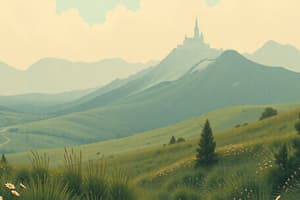Podcast
Questions and Answers
Name one notable tree species found in temperate rainforests.
Name one notable tree species found in temperate rainforests.
Western Red Cedar (Thuja plicata)
What are some predators attracted to temperate rainforests due to the salmon runs?
What are some predators attracted to temperate rainforests due to the salmon runs?
bears, seals, otters, wildcats
What are some names used to refer to grasslands in different regions?
What are some names used to refer to grasslands in different regions?
prairies, steppes, pampas
What animals burrow underground in grasslands to escape heat and predators?
What animals burrow underground in grasslands to escape heat and predators?
What adaptation do deciduous trees have to cope with temperature fluctuations and limited sunlight during winter months?
What adaptation do deciduous trees have to cope with temperature fluctuations and limited sunlight during winter months?
What common feature do temperate rainforests, grasslands, and deciduous forests share in terms of temperature?
What common feature do temperate rainforests, grasslands, and deciduous forests share in terms of temperature?
What biological adaptation allows some animals to slow metabolism and conserve energy when food is scarce?
What biological adaptation allows some animals to slow metabolism and conserve energy when food is scarce?
Which bird behavior involves traveling thousands of miles between breeding grounds and warmer winter habitats?
Which bird behavior involves traveling thousands of miles between breeding grounds and warmer winter habitats?
Which type of animals rely heavily on water temperature to regulate body functions?
Which type of animals rely heavily on water temperature to regulate body functions?
What term describes the synchronization of plant growth cycles with seasonal changes?
What term describes the synchronization of plant growth cycles with seasonal changes?
Which philosophy emphasizes maintaining sustainable relationships with land, wildlife, and spirits?
Which philosophy emphasizes maintaining sustainable relationships with land, wildlife, and spirits?
What ancient farming traditions were developed by European settlers to suit local soil types and growing seasons?
What ancient farming traditions were developed by European settlers to suit local soil types and growing seasons?
Flashcards are hidden until you start studying
Study Notes
Temperate Climates: A Diverse Palette of Ecosystems
Temperature zones shape our planet's landscapes and support diverse ecosystems teeming with life. In this exploration of temperate climates, we delve into four distinct biomes — temperate rainforests, grasslands, deciduous forests, and their inhabitants — highlighting the characteristics that make each unique within these moderately cool regions.
Temperate Rainforests
These lush evergreen forests thrive along coastal areas where moist air rises from the ocean and condenses into precipitation. With high annual rainfall and rich soil, they boast some of the richest biodiversity worldwide. Notable tree species like Western Red Cedar (Thuja plicata) span centuries old while ferns and mosses carpet the forest floor beneath towering giants. Salmon runs draw predators such as bears, seals, otters, and wildcats to this watery landscape.
Grasslands
Known also as prairies, steppes, and pampas, these expansive, treeless lands harbor numerous plant and animal species adapted to cope with semi-arid conditions. Prairie dogs and ground squirrels burrow underground to escape heat and predators alike; meanwhile, ferrets and badgers hunt them across vast tracts dotted by big bluestem grass.
Deciduous Forests
Deciduous trees shed leaves annually under temperature fluctuations and limited sunlight during winter months. These woodland communities can be found throughout North America and Europe, featuring iconic tree species like sugar maples, oak, and birch. Deer, rabbits, and rodents graze upon abundant herbage while birds flit through the leafy labyrinth seeking shelter or prey.
Life Within Moderate Temperatures
Apart from physical attributes, temperate climates facilitate a wealth of fascinating biological adaptations that enable unique existence among varying degrees of coldness and warmth. For instance:
- Seasonal Hibernation: Some animals display torpor, slowing metabolism to conserve energy when food is scarce.
- Migratory Patterns: Many bird species travel thousands of miles between breeding grounds and warmer winter habitats.
- Ectothermic Fishes: Reptiles like salamanders and amphibians rely heavily on water temperature to regulate body functions.
- Phenology: Plant growth cycles synchronize with seasonal changes, resulting in predictable patterns of reproduction and fruition.
People and Tribes Living in Temperate Zones
Indigenous peoples have dwelled alongside temperate environments since time immemorial. Their knowledge systems evolved symbiotically with surrounding ecosystems, providing insights into ecological intricacies too often overlooked today.
For example, traditional practices of First Nations people living near Pacific Northwest Coast rainforests have always respected nature's delicate balance – the philosophy known as Uxwumixw – which emphasizes maintaining sustainable relationships with land, wildlife, and spirits. Similarly, European settlers adapted agricultural techniques to suit local soil types and growing seasons, giving rise to ancient farming traditions.
In conclusion, temperate climates offer diverse habitats supporting vibrant ecosystems and human societies steeped deep within the fabric of local environments. By exploring the nuances of these biomes, one cannot help but appreciate the interconnected webs that sustain us all.
Studying That Suits You
Use AI to generate personalized quizzes and flashcards to suit your learning preferences.




